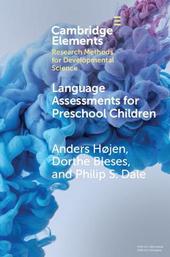
|
Language Assessments for Preschool Children: Validity and Reliability of Two New Instruments Administered by Childcare Educators
Paperback / softback
Main Details
| Title |
Language Assessments for Preschool Children: Validity and Reliability of Two New Instruments Administered by Childcare Educators
|
| Authors and Contributors |
By (author) Anders Hojen
|
|
By (author) Dorthe Bleses
|
|
By (author) Philip S. Dale
|
| Series | Elements in Research Methods for Developmental Science |
|---|
| Physical Properties |
| Format:Paperback / softback | | Pages:75 | | Dimensions(mm): Height 228,Width 153 |
|
| ISBN/Barcode |
9781108927178
|
| Classifications | Dewey:418.0076 |
|---|
| Audience | | Tertiary Education (US: College) | |
|---|
| Illustrations |
Worked examples or Exercises
|
|
Publishing Details |
| Publisher |
Cambridge University Press
|
| Imprint |
Cambridge University Press
|
| Publication Date |
4 August 2022 |
| Publication Country |
United Kingdom
|
Description
This Element has two main purposes. Firstly, it discusses purposes, advantages, and disadvantages as well as the challenges of different formats of language assessment, concluding with a focus on educator-administered language assessment in early childhood and education programs. It addresses the selection of assessment domains, the trade-off between brevity and precision, the challenge of assessing bilinguals, and accommodating the requirements of funders (e.g., government agencies) and users (e.g., educators and schools). It draws on lessons learned from developing two instruments for a national Danish-language and preliteracy assessment program. Secondly, it introduces those two educator-administered instruments-Language Assessment 3-6 (LA 3-6) and Language Assessment 2-year-olds (LA 2)-with respect to content, norming, gender and socioeconomic influences as well as psychometric qualities. The intention is that this experience can help enable the extension of the educator-based approach to other languages and contexts, while simultaneously acknowledging that linguistic and cultural adaptations are crucial.
|